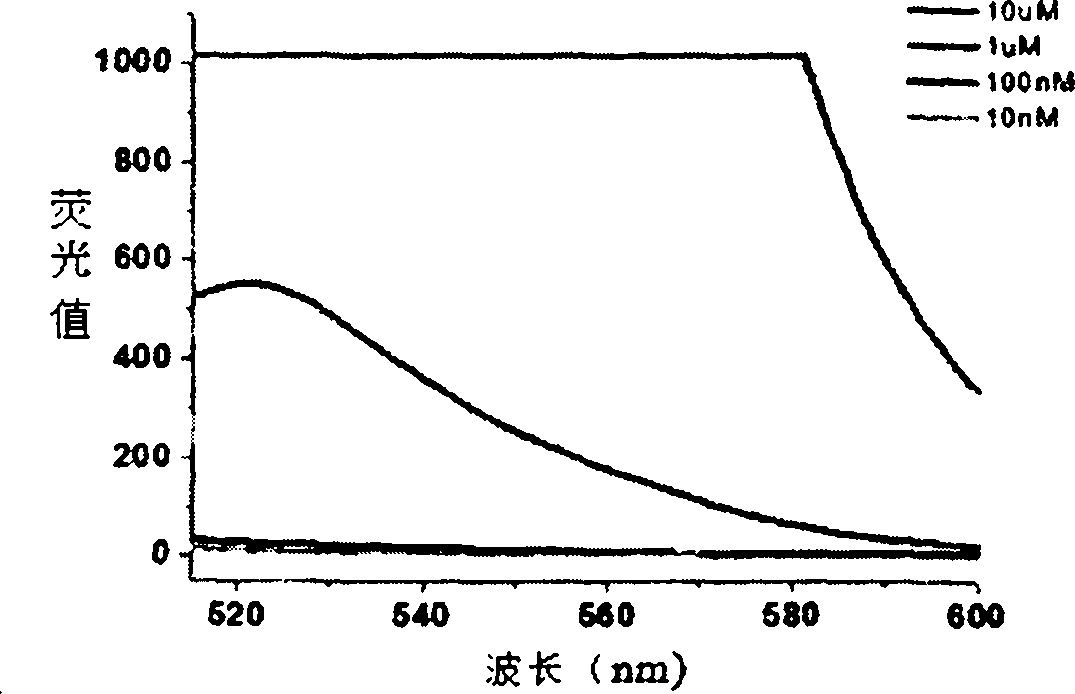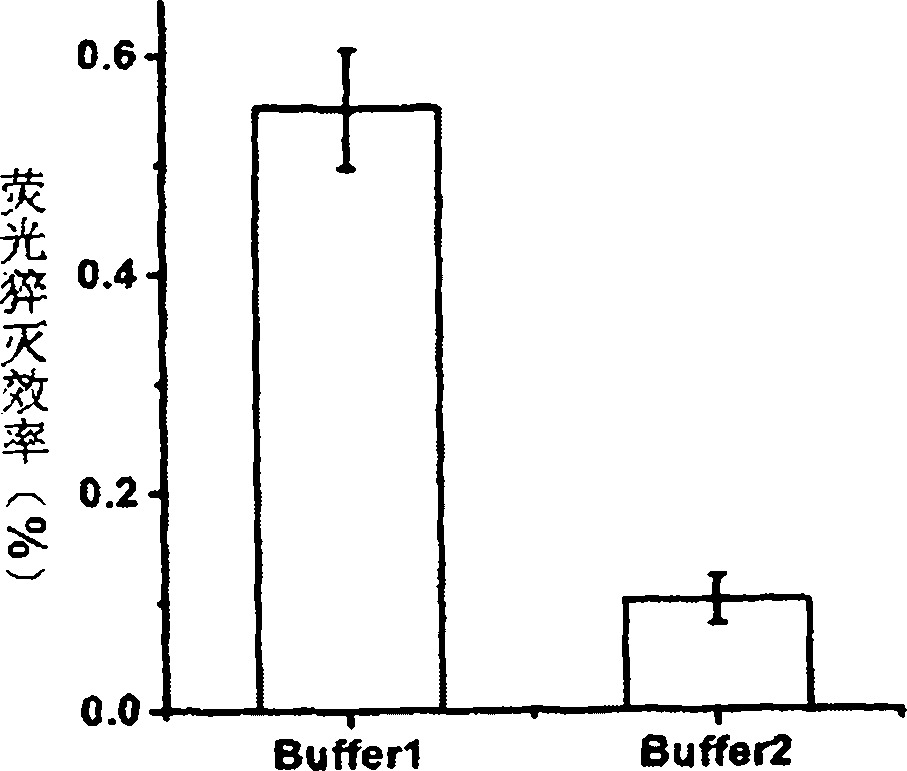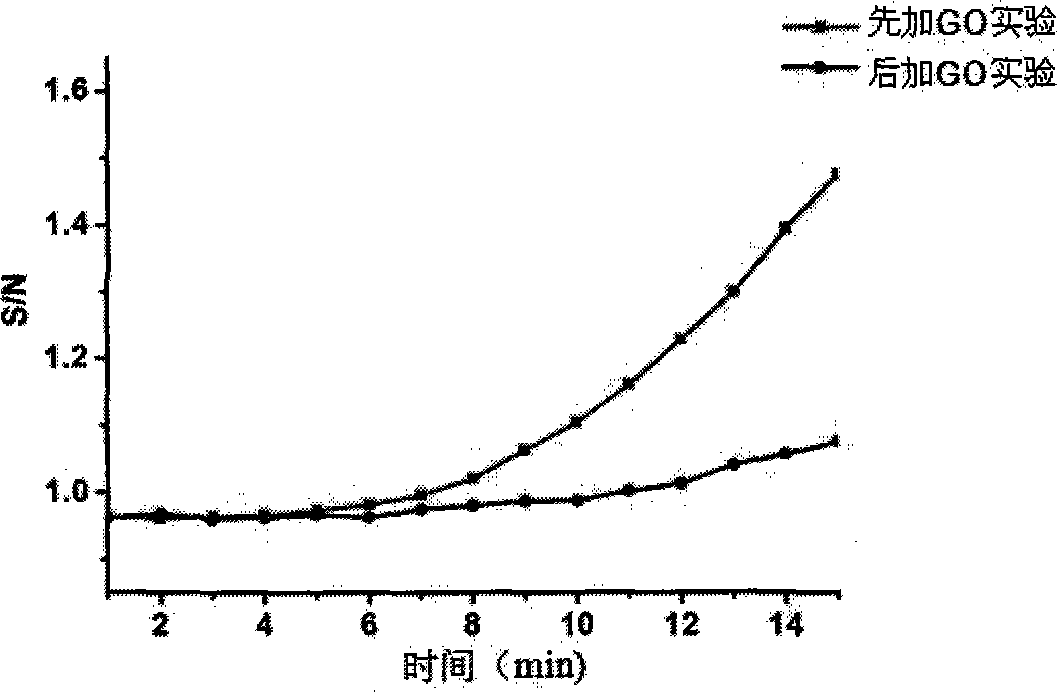MSO/GO (Mercury-Specific Oligonucleotide/Graphene Oxide) based water environment mercury ion detecting method and kit
A detection method and technology of mercury ions, which are applied in the determination/inspection of microorganisms, biochemical equipment and methods, fluorescence/phosphorescence, etc., can solve the problems of complicated and time-consuming operations, unsatisfactory, expensive costs, etc., and achieve convenient and efficient operation. Simple and low-cost effect
- Summary
- Abstract
- Description
- Claims
- Application Information
AI Technical Summary
Problems solved by technology
Method used
Image
Examples
Embodiment 1
[0038] Embodiment 1 MSO optimization design
[0039] The MSO sequence selected by the present invention is shown in Table 1, wherein MSO 1 It is a mercury ion-specific oligonucleotide probe (stem-loop structure) reported by Huang Wei et al. In order to improve the sensitivity of mercury ion detection and reduce the cost of DNA synthesis, MSO 1 Carry out an optimized design, remove the non-specific loop part (4bp), intercept the stem part (9bp) at both ends, and mark them as MSO 2 and MSO 3 .
[0040] Table 1 Mercury ion-specific oligonucleotides
[0041]
[0042] Take 2.5 μl MSO (1 μM MSO labeled with FAM fluorescein) 1 , 2μM MSO 2 , 2μM MSO 3 or FAM fluorescein-labeled MSO 2 and unfluorescently labeled MSO 3 Each 1μM mixture), add 5μl 0.5g / L GO, 265μl 20mM metal ion-containing Tris-HCl buffer, react at room temperature for 5 minutes, then add 9.3μM Hg 2+ The solution was reacted for 30 minutes, and the change of the fluorescence intensity at 522 nm was observed. ...
Embodiment 2
[0043] Example 2 Fluorescence-labeled and non-fluorescent-labeled MSO dosage optimization design
[0044] Take 2.5μl of fluorescently labeled MSO at different concentrations (10nM, 100nM, 1μM, 10μM) 2 and unfluorescently labeled MSO 3 Afterwards, 265 μl of 20 mM Tris-HCl buffer solution containing metal ions was added, reacted at room temperature for 5 minutes, and scanned the fluorescence wavelength curve with a fluorescence spectrophotometer. Fluorescence spectrum measurement conditions of the fluorescence spectrophotometer: xenon lamp excitation, slit width 10nm, response time Auto. The excitation wavelength is 496nm, and the scanning range of the emission spectrum is 515-600nm. The measurement is performed at room temperature with a 350μL microcuvette, and the fluorescence value at 522nm is recorded. The fluorescence values at 522nm of different concentrations of fluorescently labeled MSO were recorded for comparison. The result is as figure 1 : When the concentratio...
Embodiment 3
[0045] Example 3 Buffer optimization design
[0046] Prepare Tris-HCl buffer containing metal ions and Tris-HCl buffer without metal ions. Take 2.5 μl of 1 μM fluorescently labeled MSO 2 and unfluorescently labeled MSO 3 Finally, these two buffer solutions were added to scan the fluorescence wavelength curve, and the fluorescence value at the wavelength of 522nm was recorded. Finally, 5 μl of 0.5 g / L GO was added, reacted at room temperature for 5 minutes, and then scanned the fluorescence wavelength to record the change of fluorescence value. figure 2 Among them, when the Tris-HCl buffer containing metal ions was added to the reaction system, the fluorescence quenching efficiency reached (55.191±5.4)% on average before and after adding GO, which was relatively stable; when the Tris-HCl buffer containing no metal ions solution was added to the reaction system, before and after adding GO, the fluorescence quenching efficiency reached (10.108±2.2)% on average, which was much...
PUM
 Login to View More
Login to View More Abstract
Description
Claims
Application Information
 Login to View More
Login to View More - R&D
- Intellectual Property
- Life Sciences
- Materials
- Tech Scout
- Unparalleled Data Quality
- Higher Quality Content
- 60% Fewer Hallucinations
Browse by: Latest US Patents, China's latest patents, Technical Efficacy Thesaurus, Application Domain, Technology Topic, Popular Technical Reports.
© 2025 PatSnap. All rights reserved.Legal|Privacy policy|Modern Slavery Act Transparency Statement|Sitemap|About US| Contact US: help@patsnap.com



